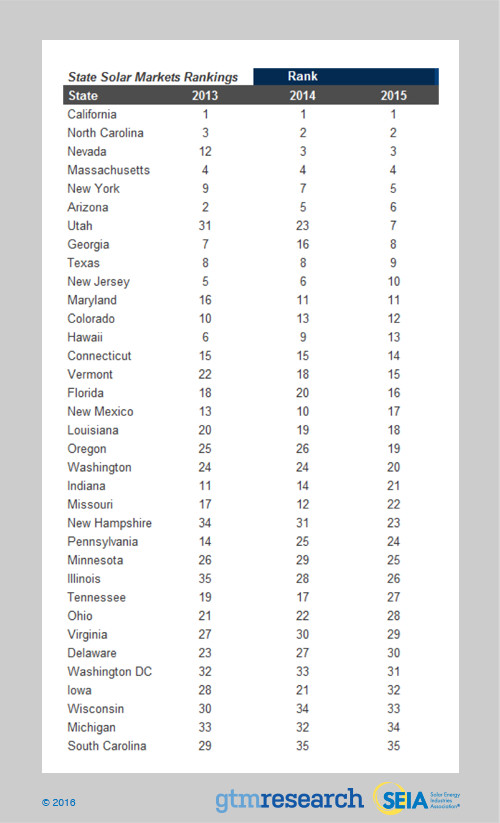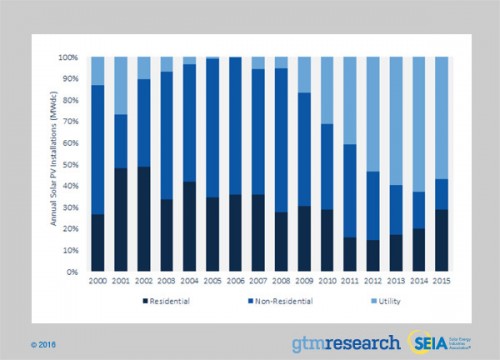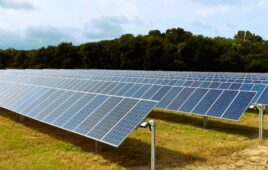In yet another record-breaking year, the solar industry in the United States installed 7,286 MW of solar photovoltaics (PV) in 2015. GTM Research and the Solar Energy Industries Association (SEIA) announced the historic figures today ahead of the March 9 release of the U.S. Solar Market Insight report.

FIGURE: U.S. Solar PV Installations, 2000-2015
Source: GTM Research / SEIA U.S. Solar Market Insight Report
For the first time ever, solar beat out natural gas capacity additions, with solar supplying 29.5 percent of all new electric generating capacity in the U.S. in 2015.
Led by California, North Carolina, Nevada, Massachusetts and New York, the U.S. solar market experienced a year-over-year growth rate of 17 percent. Geographically, the market continues to diversify with 13 states installing more than 100 MW each in 2015. States that made major solar strides include Utah, which jumped in ranking from 23rd to 7thplace, and Georgia which moved from 16th to 8th in the nation.
The residential solar market grew 66 percent year-over-year and, for the first time in history, eclipsed two gigawatts (GW). The residential solar segment now represents 29 percent of the entire U.S. solar market – its largest share since 2009.

FIGURE: Ranking States by Annual PV Installations
Source: GTM Research / SEIA U.S. Solar Market Insight Report
For the fourth year in a row, the non-residential market broke the 1 GW mark, but remained roughly flat year-over-year.
The utility-scale sector, the mainstay of the U.S. solar market, grew six percent year-over-year and represented more than half of all solar PV installed in 2015.
Cumulative U.S. solar PV installations have now topped 25 GW, up from just 2 GW in 2010.
“Without a doubt, 2015 was a monumental year for the U.S. solar industry, and perhaps what’s most amazing is that we’re only getting started,” said SEIA president and CEO Rhone Resch. “Over the next few years, we’re going to see solar continue to reach unprecedented heights as our nation makes a shift toward a carbon-free source of energy that also serves as an economic and job-creating engine.”
“The U.S. solar market remains concentrated in key states, with the top ten states accounting for 87 percent of installed capacity in 2015,” said Shayle Kann, Senior Vice President of GTM Research. “But growth has been widespread, and 24 of the 35 states that we track individually saw market growth in 2015.”
On March 9, GTM Research and SEIA will release the complete U.S. Solar Market Insight 2015 Year-in-Review with detailed market analysis and updated forecasts.

FIGURE: Share of U.S. PV Installations by Segment, 2000-2015
Source: GTM Research / SEIA U.S. Solar Market Insight Report
Key Findings:
- The U.S. installed 7,286 MWdc of solar photovoltaics (PV) in 2015, the largest total ever and 17% above 2014
- The 7.3 GW installed in 2015 is 8.6 times the capacity installed five years earlier in 2010
- Residential was once again the fastest growing sector, installing over 2 GWdc for the first time and growing 66% over 2014
- Utility solar PV also had a record year with over 4 GW installed, up 6% over 2014
- 110 MWac of concentrating solar power (CSP) capacity came online in late 2015 when SolarReserve’s Crescent Dunes project began sending electricity to the grid
- Non-residential solar was essentially flat for the third year in a row, installing just over 1 GWdc
- Cumulative solar PV installations reached over 25 GWdc by the end of the year, up from just 2 GW at the end of 2010
For more information, visit http://www.seia.org/smi.





What I do not understand about the utility Solar PV is that they are mostly doing de-forestation installation. So I landed last week at the Atlanta airport, on approach you can see that a power company has de-forested a south facing mountain side and installed Solar PV. However, just below them is a self storage center and a big box store with more roof space than the Solar PV array, so I don’t think these Utility companies are thinking with their head, they de-forested a mountain top when all they had to do was put Solar PV on the roof of a self storage and big box store.
What you don’t appear to understand is that utility-scale solar produces electricity at about than half the cost of commercial rooftop solar. The cost advantage over residential rooftop solar is even larger.
Are you willing to pay twice as much for your electricity to avoid deforestation? May so – most people are not.